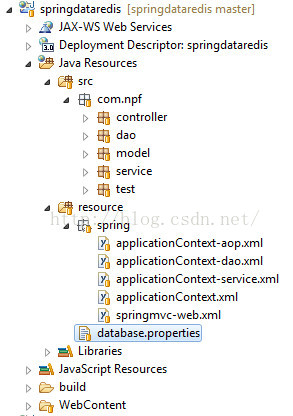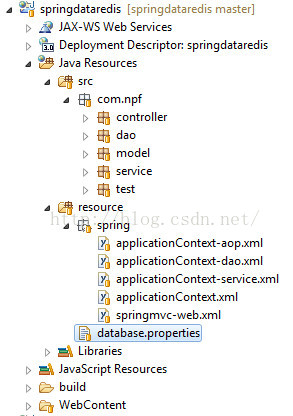分布式缓存技术——深入理解Spring Redis的使用
摘要: 关于spring redis框架的使用,网上的例子很多很多。但是在自己最近一段时间的使用中,发现这些教程都是入门教程,包括很多的使用方法,与spring redis丰富的api大相径庭,真是浪费了这么优秀的一个框架。

关于spring redis框架的使用,网上的例子很多很多。但是在自己最近一段时间的使用中,发现这些教程都是入门教程,包括很多的使用方法,与spring redis丰富的api大相径庭,真是浪费了这么优秀的一个框架。
Spring-data-redis为spring-data模块中对redis的支持部分,简称为“SDR”,提供了基于jedis客户端API的高度封装以及与spring容器的整合,事实上jedis客户端已经足够简单和轻量级,而spring-data-redis反而具有“过度设计”的嫌疑。
jedis客户端在编程实施方面存在如下不足:
1) connection管理缺乏自动化,connection-pool的设计缺少必要的容器支持。
2) 数据操作需要关注“序列化”/“反序列化”,因为jedis的客户端API接受的数据类型为string和byte,对结构化数据(json,xml,pojo)操作需要额外的支持。
3) 事务操作纯粹为硬编码
4) pub/sub功能,缺乏必要的设计模式支持,对于开发者而言需要关注的太多。
1. Redis使用场景
Redis是一个开源的使用ANSI C语言编写、支持网络、可基于内存亦可持久化的日志型、Key-Value数据库,并提供多种语言的API。
我们都知道,在日常的应用中,数据库瓶颈是最容易出现的。数据量太大和频繁的查询,由于磁盘IO性能的局限性,导致项目的性能越来越低。
这时候,基于内存的缓存框架,就能解决我们很多问题。例如Memcache,Redis等。将一些频繁使用的数据放入缓存读取,大大降低了数据库的负担。提升了系统的性能。其实,对于hibernate以及Mybatis的二级缓存,是同样的道理。利用内存高速的读写速度,来解决硬盘的瓶颈。
2. 配置使用redis
项目的整体结构如下:

在applicationContext-dao.xml中配置如下:
- <?xml version="1.0" encoding="UTF-8"?>
- <beans xmlns="http://www.springframework.org/schema/beans"
- xmlns:xsi="http://www.w3.org/2001/XMLSchema-instance"
- xmlns:context="http://www.springframework.org/schema/context"
- xmlns:mongo="http://www.springframework.org/schema/data/mongo"
- xmlns:aop="http://www.springframework.org/schema/aop"
- xsi:schemaLocation="http://www.springframework.org/schema/beans
- http://www.springframework.org/schema/beans/spring-beans-3.0.xsd
- http://www.springframework.org/schema/data/mongo
- http://www.springframework.org/schema/data/mongo/spring-mongo.xsd
- http://www.springframework.org/schema/context
- http://www.springframework.org/schema/context/spring-context-3.0.xsd
- http://www.springframework.org/schema/aop
- http://www.springframework.org/schema/aop/spring-aop-3.0.xsd">
- <context:property-placeholder location="classpath:database.properties" />
- <bean id="poolConfig" class="redis.clients.jedis.JedisPoolConfig">
- <property name="maxIdle" value="${redis.maxIdle}" />
- <property name="maxTotal" value="${redis.maxActive}" />
- <property name="maxWaitMillis" value="${redis.maxWait}" />
- <property name="testOnBorrow" value="${redis.testOnBorrow}" />
- </bean>
- <bean id="connectionFactory" class="org.springframework.data.redis.connection.jedis.JedisConnectionFactory">
- <property name="hostName" value="${redis.host}"/>
- <property name="port" value="${redis.port}"/>
- <property name="password" value="${redis.pass}"/>
- <property name="poolConfig" ref="poolConfig"/>
- </bean>
- <bean id="stringSerializer" class="org.springframework.data.redis.serializer.StringRedisSerializer"/>
- <bean id="hashSerializer" class="org.springframework.data.redis.serializer.JdkSerializationRedisSerializer"/>
- <bean id="redisTemplate" class="org.springframework.data.redis.core.RedisTemplate">
- <property name="connectionFactory" ref="connectionFactory" />
- <property name="keySerializer" ref="stringSerializer"/>
- <property name="valueSerializer" ref="stringSerializer"/>
- <property name="hashKeySerializer" ref="stringSerializer" />
- <property name="hashValueSerializer" ref="hashSerializer"/>
- </bean>
- </beans>
database.properties配置文件如下:

关于spring redis框架的使用,网上的例子很多很多。但是在自己最近一段时间的使用中,发现这些教程都是入门教程,包括很多的使用方法,与spring redis丰富的api大相径庭,真是浪费了这么优秀的一个框架。
Spring-data-redis为spring-data模块中对redis的支持部分,简称为“SDR”,提供了基于jedis客户端API的高度封装以及与spring容器的整合,事实上jedis客户端已经足够简单和轻量级,而spring-data-redis反而具有“过度设计”的嫌疑。
jedis客户端在编程实施方面存在如下不足:
1) connection管理缺乏自动化,connection-pool的设计缺少必要的容器支持。
2) 数据操作需要关注“序列化”/“反序列化”,因为jedis的客户端API接受的数据类型为string和byte,对结构化数据(json,xml,pojo)操作需要额外的支持。
3) 事务操作纯粹为硬编码
4) pub/sub功能,缺乏必要的设计模式支持,对于开发者而言需要关注的太多。
1. Redis使用场景
Redis是一个开源的使用ANSI C语言编写、支持网络、可基于内存亦可持久化的日志型、Key-Value数据库,并提供多种语言的API。
我们都知道,在日常的应用中,数据库瓶颈是最容易出现的。数据量太大和频繁的查询,由于磁盘IO性能的局限性,导致项目的性能越来越低。
这时候,基于内存的缓存框架,就能解决我们很多问题。例如Memcache,Redis等。将一些频繁使用的数据放入缓存读取,大大降低了数据库的负担。提升了系统的性能。其实,对于hibernate以及Mybatis的二级缓存,是同样的道理。利用内存高速的读写速度,来解决硬盘的瓶颈。
2. 配置使用redis
项目的整体结构如下:

在applicationContext-dao.xml中配置如下:
database.properties配置文件如下:
- redis.maxIdle=10
- redis.maxActive=20
- redis.maxWait=10000
- redis.testOnBorrow=true
- redis.host=192.168.1.76
- redis.port=6379
- redis.pass=password1
spring-data-redis提供了多种serializer策略,这对使用jedis的开发者而言,实在是非常便捷。sdr提供了4种内置的serializer:
- JdkSerializationRedisSerializer:使用JDK的序列化手段(serializable接口,ObjectInputStrean,ObjectOutputStream),数据以字节流存储,POJO对象的存取场景,使用JDK本身序列化机制,将pojo类通过ObjectInputStream/ObjectOutputStream进行序列化操作,最终redis-server中将存储字节序列,是目前最常用的序列化策略。
- StringRedisSerializer:字符串编码,数据以string存储,Key或者value为字符串的场景,根据指定的charset对数据的字节序列编码成string,是“new String(bytes, charset)”和“string.getBytes(charset)”的直接封装。是最轻量级和高效的策略。
- JacksonJsonRedisSerializer:json格式存储,jackson-json工具提供了javabean与json之间的转换能力,可以将pojo实例序列化成json格式存储在redis中,也可以将json格式的数据转换成pojo实例。因为jackson工具在序列化和反序列化时,需要明确指定Class类型,因此此策略封装起来稍微复杂。【需要jackson-mapper-asl工具支持】
- OxmSerializer:xml格式存储,提供了将javabean与xml之间的转换能力,目前可用的三方支持包括jaxb,apache-xmlbeans;redis存储的数据将是xml工具。不过使用此策略,编程将会有些难度,而且效率最低;不建议使用。【需要spring-oxm模块的支持】
其中JdkSerializationRedisSerializer和StringRedisSerializer是最基础的序列化策略,其中“JacksonJsonRedisSerializer”与“OxmSerializer”都是基于stirng存储,因此它们是较为“高级”的序列化(最终还是使用string解析以及构建java对象)。 针对“序列化和发序列化”中JdkSerializationRedisSerializer和StringRedisSerializer是最基础的策略,原则上,我们可以将数据存储为任何格式以便应用程序存取和解析(其中应用包括app,hadoop等其他工具),不过在设计时仍然不推荐直接使用“JacksonJsonRedisSerializer”和“OxmSerializer”,因为无论是json还是xml,他们本身仍然是String。如果你的数据需要被第三方工具解析,那么数据应该使用StringRedisSerializer而不是JdkSerializationRedisSerializer。
RedisTemplate中需要声明4种serializer,默认为“JdkSerializationRedisSerializer”:
1) keySerializer :对于普通K-V操作时,key采取的序列化策略
2) valueSerializer:value采取的序列化策略
3) hashKeySerializer: 在hash数据结构中,hash-key的序列化策略
4) hashValueSerializer:hash-value的序列化策略
无论如何,建议key/hashKey采用StringRedisSerializer。
spring-data-redis针对jedis提供了如下功能:
1. 连接池自动管理,提供了一个高度封装的“RedisTemplate”类
2. 针对jedis客户端中大量api进行了归类封装,将同一类型操作封装为operation接口
- ValueOperations:简单K-V操作
- SetOperations:set类型数据操作
- ZSetOperations:zset类型数据操作
- HashOperations:针对map类型的数据操作
- ListOperations:针对list类型的数据操作
3. 提供了对key的“bound”(绑定)便捷化操作API,可以通过bound封装指定的key,然后进行一系列的操作而无须“显式”的再次指定Key,即BoundKeyOperations:
- BoundValueOperations
- BoundSetOperations
- BoundListOperations
- BoundSetOperations
- BoundHashOperations
3. RedisTemplate的使用
这个类作为一个模版类,提供了很多快速使用redis的api,而不需要自己来维护连接,事务。最初的时候,我创建的BaseRedisDao是继承自这个类的。继承的好处是我的每个Dao中,都可以自由的控制序列化器,自由的控制自己是否需要事务,这个先不需要了解,跟着我目前的这种配置方法来即可。template提供了一系列的operation,比如valueOperation,HashOperation,ListOperation,SetOperation等,用来操作不同数据类型的Redis。并且,RedisTemplate还提供了对应的*OperationsEditor,用来通过RedisTemplate直接注入对应的Operation。
核心代码:
- package com.npf.dao.impl;
- import java.util.ArrayList;
- import java.util.List;
- import java.util.Map;
- import java.util.Map.Entry;
- import javax.annotation.Resource;
- import org.springframework.beans.factory.annotation.Autowired;
- import org.springframework.data.redis.core.HashOperations;
- import org.springframework.data.redis.core.RedisTemplate;
- import org.springframework.stereotype.Repository;
- import com.npf.dao.StudentDao;
- import com.npf.model.Student;
- @Repository
- public class StudentDaoImpl implements StudentDao{
- @Autowired
- private RedisTemplate<String,Student> redisTemplate;
- @Resource(name="redisTemplate")
- private HashOperations<String,String,Student> opsForHash;
- public static final String STUDENT = "student";
- @Override
- public void save(Student student) {
- opsForHash.put(STUDENT, student.getId(), student);
- }
- @Override
- public Student find(String id) {
- Student student = opsForHash.get(STUDENT, id);
- return student;
- }
- @Override
- public void delete(String id) {
- opsForHash.delete(STUDENT, id);
- }
- @Override
- public void update(Student student) {
- opsForHash.put(STUDENT, student.getId(), student);
- }
- @Override
- public List<Student> findAll() {
- Map<String, Student> entries = opsForHash.entries(STUDENT);
- List<Student> stuList = new ArrayList<Student>();
- for(Entry<String, Student> entry : entries.entrySet()){
- stuList.add(entry.getValue());
- }
- return stuList;
- }
- }
- package com.npf.controller;
- import java.util.List;
- import java.util.UUID;
- import org.springframework.beans.factory.annotation.Autowired;
- import org.springframework.stereotype.Controller;
- import org.springframework.ui.Model;
- import org.springframework.web.bind.annotation.RequestMapping;
- import org.springframework.web.bind.annotation.RequestParam;
- import com.npf.model.Student;
- import com.npf.service.StudentService;
- @Controller
- public class StudentController {
- @Autowired
- private StudentService studentService;
- @RequestMapping("/student/save")
- public String saveStudent(Student student){
- String id = UUID.randomUUID().toString();
- System.out.println(id);
- student.setId(id);
- studentService.save(student);
- return "redirect:/student/find/all";
- }
- @RequestMapping("/student/update")
- public String updateStudent(Student student){
- studentService.update(student);
- return "redirect:/student/find/all";
- }
- @RequestMapping("/student/to/save/form")
- public String toSaveStudentForm(){
- return "save";
- }
- @RequestMapping("/student/delete")
- public String deleteStudent(@RequestParam("id") String id){
- studentService.delete(id);
- return "redirect:/student/find/all";
- }
- @RequestMapping("/student/to/update/form")
- public String toUpdateStudentForm(@RequestParam("id") String id,Model model){
- Student stu = studentService.find(id);
- model.addAttribute("stu", stu);
- return "update";
- }
- @RequestMapping("/student/find/all")
- public String findStudents(Model model){
- List<Student> stuList = studentService.findAll();
- model.addAttribute("stuList", stuList);
- return "list";
- }
- }
本文作者:佚名
来源:51CTO
- 本文标签: Hadoop list cat dist API bean 分布式 java 实例 https final 开发者 Word 二级缓存 CTO classpath value 数据库 client 管理 Service jedispool spring DOM 开发 UI http cache 设计模式 web key find schema IDE Property id 解析 自动化 入门教程 配置 core 时间 mapper apache XML Connection redis connectionFactory AOP HTML tab mybatis map src 代码 ORM mongo update json js 开源 数据 ACE IO App
- 版权声明: 本文为互联网转载文章,出处已在文章中说明(部分除外)。如果侵权,请联系本站长删除,谢谢。
- 本文海报: 生成海报一 生成海报二











![[HBLOG]公众号](https://www.liuhaihua.cn/img/qrcode_gzh.jpg)

